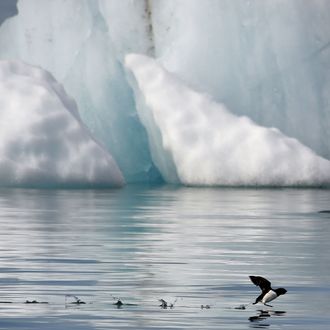
Good news for anyone who wants their grandkids to see all of our coastal cities swallowed by rising tides: The extent of Arctic sea hit a record low last month, according to the National Snow and Ice Data Center. And May’s showing broke that record by no piddling margin — ice extent was 224,000 square miles lower than the previous record set in 2004. It was also 537,000 square miles beneath the long-term average from 1981 to 2010. If the pattern of higher-than-average monthly temperatures continues through summer, there’ll be less ice in the Arctic sea this September than at any time on record.
The melting of Arctic sea ice does not directly raise sea levels (because the ice is floating), but it does accelerate the pace of global warming: Ice and snow reflect sunlight; ocean water absorbs it.
In a complementary sign of impending disaster, May also saw a record-high level of carbon dioxide in the Earth’s atmosphere: For everyone 1 million molecules in the air, 407.7 were CO2 — 3.76 higher than in May 2015, which also happens to be the largest year-over-year increase ever recorded.
If the United States didn’t have such a strong bipartisan consensus on the necessity of radical action to combat climate change, humanity would really be in a pickle.






























